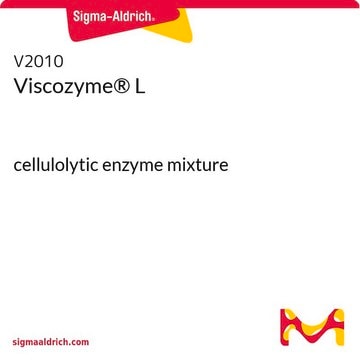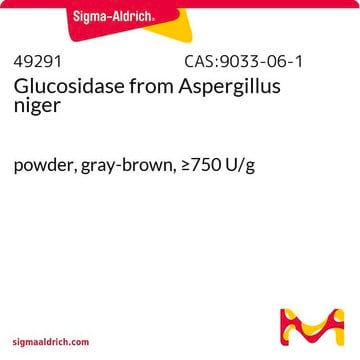SAE0020
Cellulase, enzyme blend
Synonym(s):
Cellic CTec2
Sign Into View Organizational & Contract Pricing
All Photos(3)
About This Item
UNSPSC Code:
12352204
NACRES:
NA.54
Recommended Products
Related Categories
General description
Cellulase is a member of glycoside hydrolase family and is produced by a number of cellulolytic microbes.
This product contains cellulases, ß-glucosidases, and hemicellulase, for the application of degrading cellulose to fermentable sugars. This product is effective on a wide variety of pre-treated lignocellulosic bimass materials, for converting the carbohydrates in these materials into simple sugars prior to fermentation, for application in biofuels research.
Application
Cellulase, enzyme blend has been used for the purpose of enzymatic hydrolysis.
Biochem/physiol Actions
Cellulase is responsible for the breakdown of insoluble plant polymer cellulosic substrates into soluble sugars, mostly cellobiose and glucose. It specifically catalyzes the hydrolysis of β -1,4 glucosidic bonds in cellulose. Animals do not naturally possess the ability to digest cellulose, but do so with the help of gut microorganisms.
Legal Information
A product of Novozyme Corp
Signal Word
Danger
Hazard Statements
Precautionary Statements
Hazard Classifications
Resp. Sens. 1
Storage Class Code
10 - Combustible liquids
WGK
WGK 3
Certificates of Analysis (COA)
Search for Certificates of Analysis (COA) by entering the products Lot/Batch Number. Lot and Batch Numbers can be found on a product’s label following the words ‘Lot’ or ‘Batch’.
Already Own This Product?
Find documentation for the products that you have recently purchased in the Document Library.
Customers Also Viewed
Model of acetic acid-affected growth and poly (3-hydroxybutyrate) production by Cupriavidus necator DSM 545.
Marudkla J, et al.
Journal of Biotechnology, 268, 12-20 (2018)
Qiulu Chu et al.
Biotechnology for biofuels, 14(1), 136-136 (2021-06-14)
Ethanol organosolv (EOS) pretreatment is one of the most efficient methods for boosting biomass saccharification as it can achieve an efficient fractionation of three major constituents in lignocellulose. However, lignin repolymerization often occurs in acid EOS pretreatment, which impairs subsequent
Zhe Ling et al.
Bioresource technology, 305, 123025-123025 (2020-03-03)
Discovering green solvents and their inner mechanisms for efficient deconstruction of lignocellulosic biomass recalcitrance are receiving growing interests. In this work, eco-friendly levulinic acid (LA) based deep eutectic solvents (DES) were proposed for pretreatment on moso bamboo by combining acetamide
Liwen He et al.
Frontiers in microbiology, 12, 690801-690801 (2021-09-14)
Vanillic acid (VA) is a phenolic acid derivative commonly found in plants and foods, with a pleasant creamy odor and pharmacologic activities, which is hypothesized to help improve silage fermentation. The silage profile of stylo silage ensiled with addition of
Angela S Machado et al.
Frontiers in bioengineering and biotechnology, 8, 826-826 (2020-08-09)
The ability of white-rot fungi to degrade polysaccharides in lignified plant cell walls makes them a suitable reservoir for CAZyme prospects. However, to date, CAZymes from these species are barely studied, which limits their use in the set of choices
Our team of scientists has experience in all areas of research including Life Science, Material Science, Chemical Synthesis, Chromatography, Analytical and many others.
Contact Technical Service









